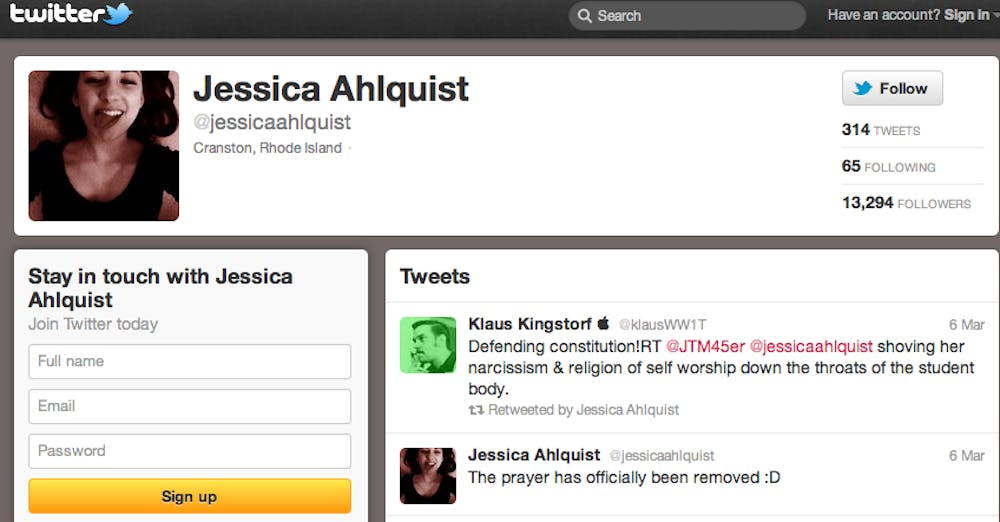Last month, a Tennessee high school student was prevented from publishing an editorial in her school paper titled “No Rights: The Life of an Atheist.”
School officials censored editor Krystal Myers on grounds that the piece could cause disruption in the predominantly Christian student body.
What her school did was absolutely legal. If they saw that Myers’ editorial had the potential to disrupt the school and present a danger to students, the school did its job. Differences in religion have a tendency to cause conflict, especially in predominantly Christian areas like Lenoir City, T.N.
However, the points Myers made in her would-be editorial - that it’s tough to be an atheist in a Christian student body and that church and state are not always separated in public schools - are valid.
I don’t have the same restrictions as Krystal Myers, so perhaps this opinions piece can serve as the discussion about religion in public schools that a public school couldn’t publish.
Like Myers, I grew up in a southern town where churches lined the streets like Starbucks.
Everyone was Christian, including me, until high school when I began to question my beliefs and identify with secular humanism (a polite substitute for atheism I use to avoid negative stigmas).
I had few friends in high school, which I attribute to an organization called YoungLife. Their mantra seemed to be “Come for the music, food and games. Stay for the Jesus.” At first, it was a few who heard about it through their churches, then they started bringing their friends, then the public school started letting in YoungLife counselors (adults given school IDs to hang out with YoungLife members and recruit more), and before I knew it YoungLife took the school.
My peers spent their lives at YoungLife scavenger hunts, movie nights, and bible studies. I was invited, of course, but I declined because I was at that time a closeted atheist, fearful of what they might think of my beliefs. Consequently, I was usually on my own, or with a few other quietly non-religious outcasts.
Organizations like YoungLife are an important part of some Christian students’ lives, but they’re also a subtle new form of proselytism. Becoming Christian to please the majority was not only an option for the silent, non-religious students at my school, it was a reality for those who couldn’t stand the isolation.
It’s alienation, and that’s where we must be wary of religion in public schools. We don’t have to take religion out entirely, but we should make it a subject of learning, not a tool for exclusion.
Let me clarify, I do not believe, as Rick Santorum does, that “intelligent design” should be taught in biology classes. There are active bills in the state legislatures of New Hampshire, Missouri, Indiana and Oklahoma that would mandate the teaching of this pseudoscience alongside actual science. Intelligent design has no grounding in evidence or fact. It’s clever phrasing for the not-so-clever concept that “God did it” and no more explanation is needed.
Where religion does have value in public schools is as a solution to religious ignorance.
A study at the University of Minnesota found that 34 percent of Americans would disapprove of their children marrying Muslims. Forty-eight percent said the same for atheists.
In April 2011, high school junior and atheist Jessica Ahlquist caused uproar in Rhode Island when she sued her predominantly Catholic, public school over the display of a school prayer banner in her auditorium. The banner alienated Ahlquist, and at great cost to her reputation, she fought to remove it on grounds that it violated the First Amendment. In January, she won her case at district court.
Following the ruling, Ahlquist has required a police escort to classes. She has received threats, and a state representative referred to her as “evil.” She has been treated with scorn because her beliefs didn’t line up with the majority, and she simply asked for respect.
But what if rather than one Catholic banner, the school offered an array of cultural adages from Buddhism, Islam, Christianity, or any number of world religions or cultures? Make it a display of diversity rather than uniformity.
The chief enemy in the battle for religious tolerance is ignorance, and the solution to ignorance is education. Perhaps we should allow public schools to teach religion; not spiritually, but culturally. We should put an end to religion’s capacity to exclude students, and establish public schools as institutions of free thought, discussion and learning for students of all beliefs and world-views.
We could create a generation of understanding that might someday make religious tolerance a reality.


